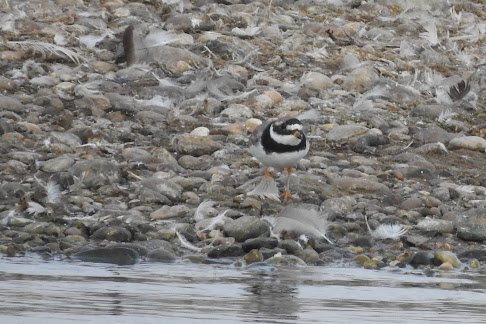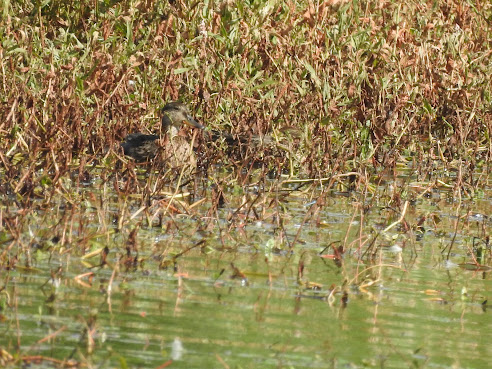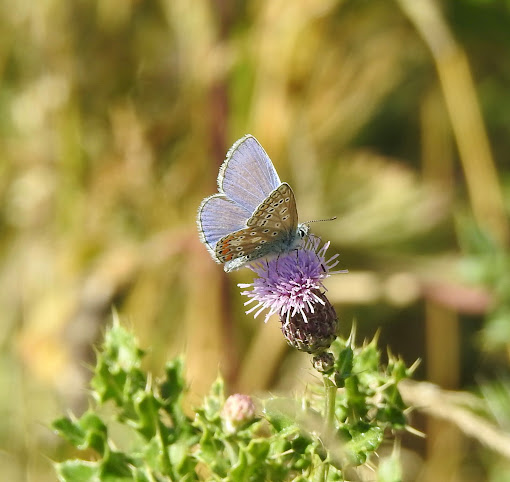The hot weather has returned, dampening the birding spirits but stoking the fires of moth enthusiasm.
I made a pretty token attempt to go birding yesterday, choosing Lower Bittell for a change, and getting precious little reward. I ended up identifying plants (it was that bad). The previous night a little moth had found itself in our bathroom and turned out to be Coptotriche marginea, my first since 2018. I took it as a sign.
So the trap went out on Tuesday night, and I have to say it was a pretty successful session. The final haul reached 123 moths of 47 species which included four/five new for the garden and another ten/eleven new for the year.
Just to deal with the issue of how many garden ticks I got, one was a migrant micro called Rush Veneer not seen since I got the moth trap, so new for the garden. Except that in the days when I relied on the bathroom, no camera, and no internet searches (just the field guide) I recorded one in 2015. So not technically a garden tick, but it is now added to the list.
 |
| Rush Veneer |
I don't often see genuine migrant moths, so I was pleased to get it.
The other four garden ticks were also micros, but mostly they were quite big micros. The first was resting about seven feet up on the outside of the utility room shortly after 05.00 am. I grabbed a stool and got a shot of it before it made a sharp exit. It turned out to be a Dusky Pearl, Udea prunalis. This is a common moth, found throughout the UK, so it was about time I had one.
 |
| Udea prunalis |
One of the things about recording micros is that I'm never completely certain that I'm not throwing away potential lifers. My next moth came in that category. It looked like the grass moth Agriphila tristella, which I hadn't seen yet this year, so I took a photo. Then I checked with the Obsidentify app and that said Agriphila selasella 100%. Oops.
 |
| Agriphila selasella |
I checked the photo against other images, and finally ran it passed the on-line expert UKMothIdentification and there was no reason to doubt the app. I was slightly comforted that this species is less common than tristella, but I do wonder how many others I've cocked up.
The next goody was a remarkably patterned moth intercepted as it attempted to escape. I knew immediately it was not something I'd seen before, and that I wasn't even sure what genus it was. This was another one for the app, and that gave me a 97% confidence identification of Anacampsis blattariella.
 |
| Anacampsis blattariella (Probably) |
The image in the book was broadly supportive, and I couldn't see another that looked like it, so I let it go. Since then I've done some more research, and it seems that there are two difficult to separate, highly variable Anacampsis moths, of which this is the rarer. To get the record fully accepted a specimen is recommended. I tried running it past UKMothIdentification, and he had no quibbles about the app's identification, so I'm ticking it. The caterpillar has been recorded on birch and alder, and both occur at nearby Ipsley Alders. However, the rival moth's caterpillar lives on poplars and there are some of those a similar distance away. I suspect the recorder will want it recorded as either/or.
The last garden tick was on the small side. I took its photo, but didn't have high hopes for an identification. The app excelled itself, and came up with Scrobipalpa costella. Double-checking the image with the Internet, it still looked plausible so I ran it passed UKMothIdentification, and he concurred.
 |
| Scrobipalpa costella |
This rather dowdy little moth is apparently reasonably common throughout the UK.
I think I have found a happy medium between trusting the app and following other lines of enquiry. The app struggles with adventives like the common Australian species Light Brown Apple Moth which doesn't appear to be in its database, but it can be brilliant in cutting down on the hours of research I usually have to go through for most European moths.
New for the year were the macros Oak Hook-tip, Lime-speck Pug, Common Carpet, Flounced Rustic, Square-spot Rustic, Straw Underwing, Orange Swift, and Maiden's Blush (first since 2019).
 |
| Maiden's Blush |
I also recorded Mother of Pearl and Ypsolopha dentella as new for year micros.
I have no intention of twitching the Cape Gull currently attracting the hoards at Grafham Water. It seems I am quite content pottering around locally, noticing and recording whatever is on offer.
I'm a happy man.
The evening produced an extra tiny moth which may turn out to be very rare indeed (according to the app), or maybe not. I'm afraid it's in the freezer awaiting identification. At the moment it's Scrobipalpa ag.






































.jpeg)






